Michigan is one of the states with a high number of fish species of various sizes. From planktivores to true predators, various species are found in the streams, rivers, and ponds of the state.
Direct access to Lake Michigan and Lake Hudson makes the state one of the ideal areas for fishing in the Northern US.
The following species found in Michigan are mostly native to the state while a few of them are invasive, with a negative impact on other fish or local plants and aquatic vegetation.
Table of Contents
1. Largemouth Bass
Largemouth Bass (Micropterus salmoides) are a native species in Michigan that grows to 29 inches.
This olive green species is one of the most common predators in the state and the area of The Great Lakes.

Largemouth Bass are among the typical predators that live more than 10 years. They may weigh up to 25 lbs.
Fish and crustaceans are part of its diet. Largemouth Bass help control small invasive fish populations in the area of The Great Lakes such as The Round Goby.
Anglers typically release the largest caught Largemouth Bass as these are typically females, helping fish numbers in the area.
2. Bluegill

A common species across the state, Bluegill (Lepomis macrochirus) is among the fish eaten by Largemouth Bass.
Bluegill is considerably smaller than Largemouth Bass, measuring a maximum of 12 inches.
As Largemouth Bass, Bluegill also has green or olive-green coloring with dark olive bands along the sides.
A flattened body and a pumpkin seed shape are specific to Bluegill. The fish eats all types of small foods, but mostly insects.
Bluegill is a fish species of The Great Lakes. They live at great depths and may be spotted closer to the surface on cold winter mornings when they need to warm up.
3. Smallmouth Bass
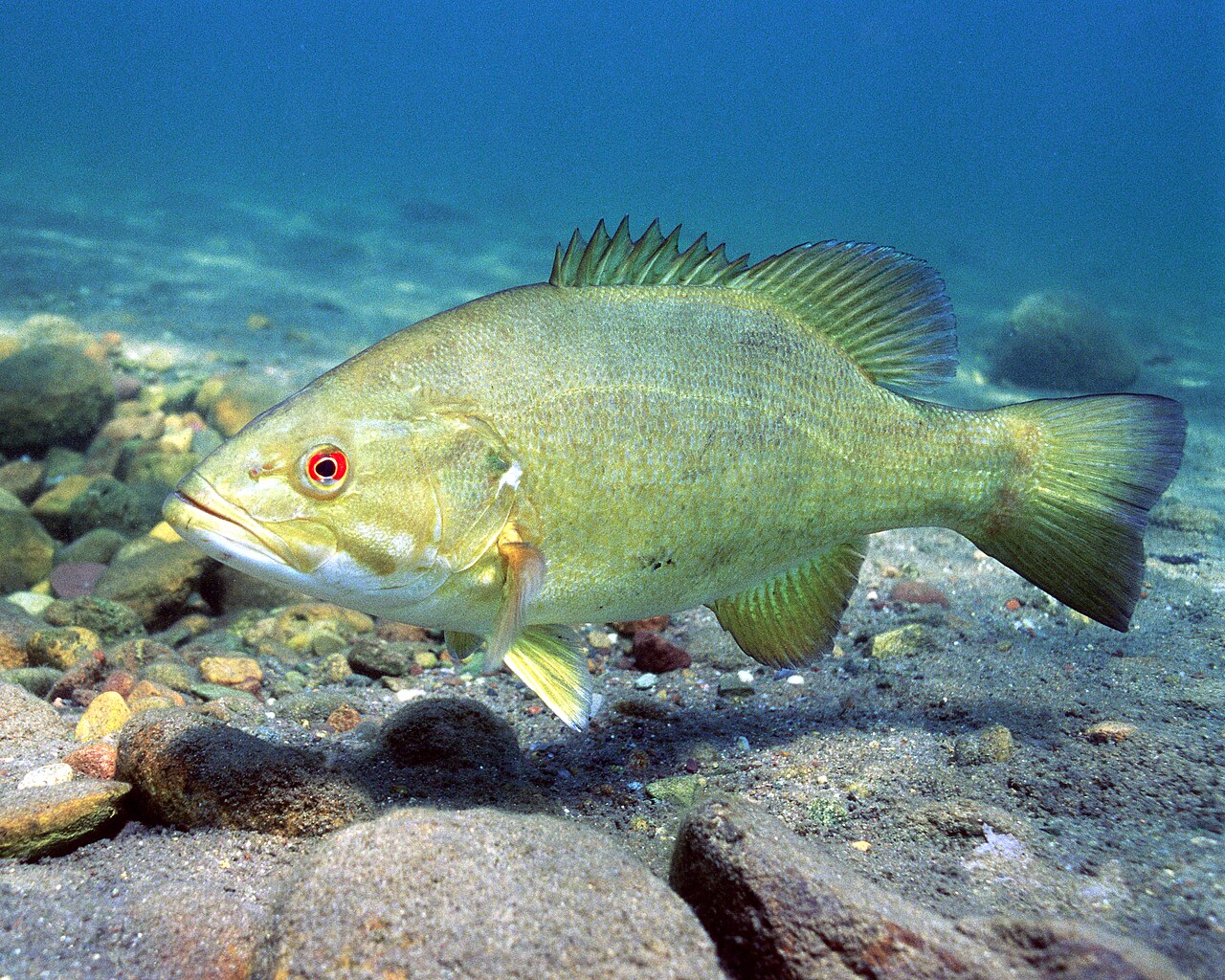
Smallmouth Bass (Micropterus dolomieu) is a species found in the areas of The Great Lakes. It also lives in the St. Lawrence River which connects the lakes from Lake Ontario to The Atlantic Ocean.
Fish of the species live in areas with clear water compared to other types of bass.
The species may grow to a record-holding size of 27 inches.
A dark olive-green color or an olive-brown color is specific to its dorsum while its ventral coloring is bright yellow.
Small fish, crayfish, and different types of water bugs are eaten by Smallmouth Bass.
4. Rock Bass

A type of Sunfish, Rock Bass (Ambloplites rupestris) is a native species in the Northern parts of Michigan in The Great Lakes and further into the St. Lawrence River.
Fish of the species live in rocky areas of lakes with plenty of vegetation, typically close to the margins of lakes and ponds.
The species may survive more than 10 years and it may reach a maximum length of 10 inches.
Fish of the species are carnivorous and eat other small fish such as yellow perch.
They are also eaten by larger fish such as Northern Pike.
5. Round Goby

Round Gobies (Neogobius melanostomus) are an invasive species in the state.
Accidentally introduced from Asia, this species is now present in high numbers in The Great Lakes.
This species eats snails, mussels, and crustaceans.
The invasive status of The Round Goby is given by its elimination of local food sources other species eat.
Generally more aggressive than other fish, Round Goby is also eaten by some of the largest predators of the state such as Smallmouth and Largemouth Bass.
6. Pumpkinseed

One of the smallest common species in the state is Pumpkin seed fish (Lepomis gibbosus). This species measures an average of 4 inches and it may weigh up to 1 pound.
A flattened body and shape that resembles the seeds of pumpkins describe the way this species looks like.
Orange, olive, and yellow colors are all characteristic of the species.
Warm shallow lake and pond water represent the ideal habitat for the species. Pumpkinseed also lives in areas with dense vegetation and is opposed to species that cannot tolerate reduced oxygenation.
Insects and crustaceans are among the small prey eaten by Pumpkinseed.
7. Northern Pike

Northern Pike (Esox lucius) is one of the most aggressive large predatory fish in the state.
This is a species that leaves at least a decade and which has adapted to excellent preying skills. It sits motionless awaiting its prey.
Fast movements allow Northern Pike to ambush smaller fish.
This is a species that lives in almost any habitat that has smaller fish around.
High levels of cannibalism are also specific to the species over long periods without any suitable prey.
8. Yellow Perch

This type of fish (Perca flavescens) also has a flattened body and it lives in The Great Lakes as well as in the St. Lawrence River.
It has an important role in the ecosystem as it serves as food for local birds. Cormorants are among the birds that depend on Yellow Perch for food.
A small species and a poor swimmer, Yellow Perch is a suitable prey for these large birds.
However, cormorants are solely responsible for eating a large number of Yellow Perch in small areas of the lakes.
Fishermen also appreciate Yellow Perch as a species that puts up fair resistance.
9. Brook Stickleback
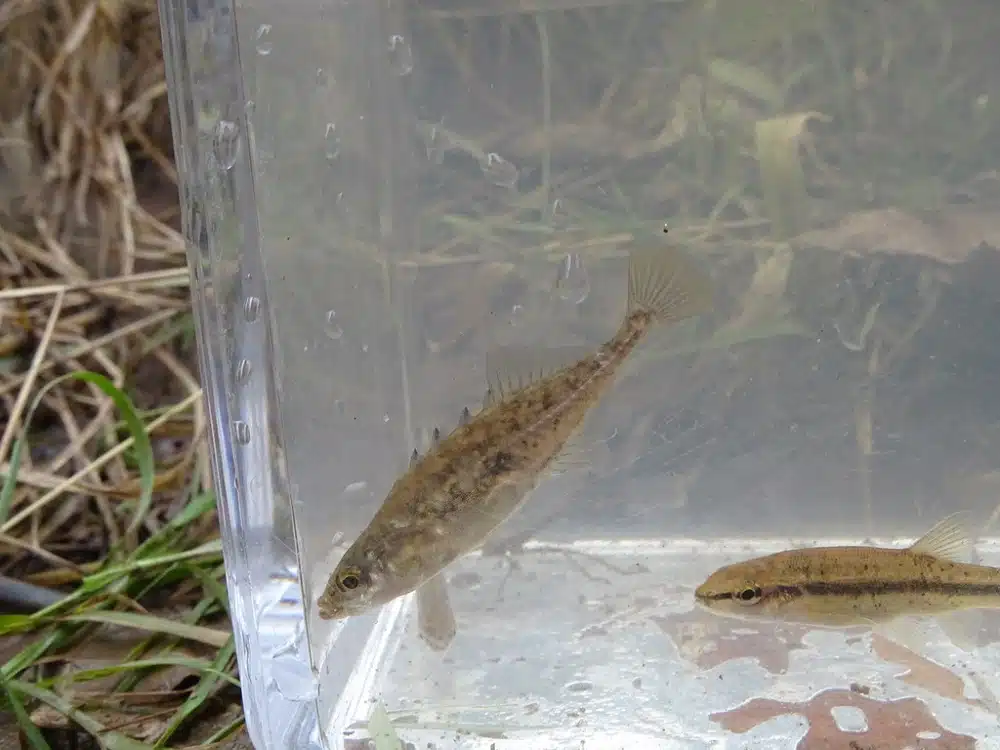
Brook Sticklebacks (Culaea inconstans) are one of the smallest species in Michigan.
These fish measure an average of 2 inches and often serve as food for some of the largest predatory fish in the state.
In turn, Brook Stickleback feed on fish eggs, invertebrates, and algae.
They have almost no real competition for fish eggs except minnows given their reduced size. A cannibalism habit towards the eggs of their own species has also been identified with Brook Sticklebacks.
10. European Carp

European Carp (Cyprinus carpio) is one of the most common species in the area of The Great Lakes. This is one of the fish that is truly omnivore, even reducing the food sources for local fish.
A high multiplication rate is specific to these fish as females can lay millions of eggs at once.
European Carp is one of the most common aquaculture fish in the world.
In Michigan, this common species is prized by anglers who are getting into the species and slowly catching up to the popularity of the fish in Europe.
11. Alewife

This gray fish (Alosa pseudoharengus) is one of the multiple invasive species in Northern Michigan. It has made its way to The Great Lakes where it has been subject to multiple management techniques.
Alewife fish are known for impacting zooplankton numbers here. In turn, this led to a direct decline of multiple native species in these large lakes.
Alewife isn’t as common as it used to be, partly because predators that eat the species were introduced. Pacific Salmon is one of the introduced species to control its numbers here.
12. Creek Chub

This small fish (Semotilus atromaculatus) is among the common species that are seen in communal sites when spawning.
Small Creek Chub fish are further known for sheltering during the night when the water is cold. They typically eat early in the morning and they might wait until the sun is up to go out for food.
This species prefers to hide in creeks in rivers and small streams, as their name implies.
Creek Chub populations are now diminishing in lakes such as those of The Great Lakes. While they can live both in lakes and streams, Creek Chub prefer to live in streams.
13. Brown Trout

Brown Trout (Salmo trutta) is one of the most popular introduced species in the area of The Great Lakes. The species is self-sustained in this habitat.
They can live both in the lakes and in streams connected to these lakes.
Brown Trout can grow to 39 inches and 44 lbs in lakes and a bit smaller and lighter in streams and rivers.
Known for its multiple brown spots, this fish species is now becoming as popular with North American anglers as with European anglers.
Unlike many local fish, Brown Trout can also live long lives. It can survive on its own for up to 20 years.
14. Green Sunfish

A common species in the Northern parts of the state, Green Sunfish (Lepomis cyanellus) is a species native to North America.
The species is now spread through many other states.
This is a fish that can be caught by anglers using insects. Green Sunfish eat a range of insects as well as the larvae of many aquatic species.
Known for its slightly blue nuance gray color, this species can live in all types of water, including murky water with lower oxygen.
15. Brook Trout
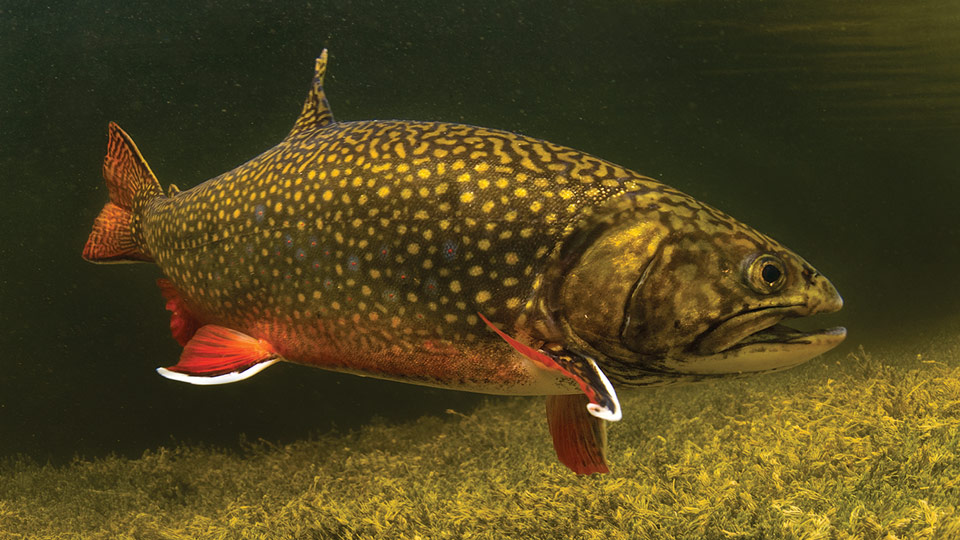
The Great Lakes are home to the Brook Trout (Salvelinus fontinalis). St. Lawrence River basin is also known for being a good habitat for the species.
This is a darker type of trout with green to brown coloring covering its spotted body.
One of the largest Brook Trout caught here measures just over 30 inches and the species is one of the prized game fish anglers are interested in.
This type of fish only lives in the cleanest areas of these large lakes with good to very good oxygenation.
Bugs and insects are the main foods of the species. Both aquatic and terrestrial insects are eaten by the species. Terrestrial bugs end up in the water when they fall from overhanging vegetation.
16. Rainbow Trout

Rainbow Trout (Oncorhynchus mykiss) is one of the multiple invasive species in The Great Lakes.
This fish is established both in the lakes and in the streams connected to these lakes. Its size depends on its location as the largest Rainbow Trout lives in these lakes.
Migration for spawning is possible with the species which may return to its native area even after years.
Seen in different colors, the species is one of the invasive status fish of the world with a high impact on food competition when it comes to its role to other species.
Stoneflies and mayflies are some of the specific insects Rainbow Trouts are attracted to, but they are omnivore predators.
17. Central Mudminnow
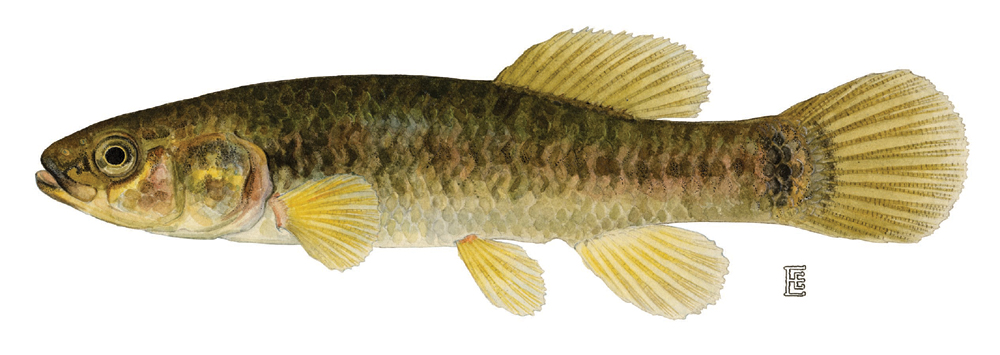
Central Mudminnow (Umbra limi) is one of the burrowing species in the state.
This fish knows how to burrow using its tail. It enters burrows only leaving its head out.
Fish of the species are an important chain in the ecosystem as prey for other Michigan fish such as Northern Pike.
Amphipods are preferred by the species to other types of plankton.
The small fish adaptable to low oxygen levels is seen spawning since April.
18. Common Shiner

Slightly larger, Common Shiner (Luxilus cornutus) are a species that grows to 7-8 inches. This silver-gray fish is seen in the Northern parts of the state.
With a lifespan of up to a few years, females of the species lay up to a few thousand eggs per season.
Vegetation and insects are among the main foods and concerns of the species during the day.
A reduced size over the first couple of years also makes this species vulnerable to larger predators.
Smallmouth Bass is among the common Michigan species that eat Common Shiner.
19. White Sucker

Lakes and streams of the state are also populated by White Sucker (Catostomus commersonii).
Mainly identified by the shape of its mouth while feeding, White Sucker fish are a constant presence at the sediment level where they feed on invertebrates, algae, and plants.
Bass, walleye, and trout are among the larger and more common predators of the state that feed on it.
A fish that isn’t particularly tasty, White Sucker may sometimes be used by fishermen to lure in larger predators.
This silver to dark silver species grows to a size between 10 and 20 inches and may be used as bait for Northern Pike and other local predators.
20. Northern Sunfish

Colorful and small Northern Sunfish (Lepomis peltastes) are native to the region of The Great Lakes.
This species feeds on small fish eggs and insects or water bugs such as various mites.
While small, the species shows reduced resilience in front of water pollution or higher turbidity.
It has been facing lower numbers in areas of the state where water is affected by industrial or agricultural pollution.
Northern Sunfish may sometimes be spotted in shallow water with plenty of aquatic vegetation where it hides from large predators.
21. Lake Trout

Lake Trout (Salvelinus namaycush) are one of the largest species of trout in the state. This is a fish that may also be referred to as Mud Hens, particularly when having a darker color.
It once used to be the most commercially fished species in The Great Lakes, but its numbers have diminished considerably.
Lake Trout is among the largest types of trout, even if it grows very slowly.
It may reach lengths of around 50 inches and a weight of around 100 lbs up to the age of 10.
While only small numbers of fish remain in The Great Lakes, these fish is still allowed to be captured by small commercial fisheries.
22. Black Crappie

Black Crappie fish (Pomoxis nigromaculatus) are found in water with plenty of vegetation.
This small fish doesn’t have a long lifespan as it may only survive for a couple of years.
High activity levels in lakes and streams are noted for Black Crappie at night, its ideal feeding time.
This species feeds on plankton and various other very small fish.
While Black Crappies can live more than a decade, most fail to survive more than a few years as they fall prey to large predators.
23. Freshwater Drum

Freshwater Drum (Aplodinotus grunniens) is a common mid-sized species in the state.
Female Freshwater Drum is slightly larger than males but they also take longer to sexually mature.
It may take at least 6 years for the females to be ready to lay eggs while males are ready for spawning sooner.
This is a species that is seen in shallow water in the summer. This is the spawning season when the female seeks the warmest shallow waters to lay eggs in.
These eggs then float for a few days before hatching without any male or female maternal care.
24. Chinook Salmon

Chinook Salmon (Oncorhynchus tshawytscha) is one of the introduced species in Lake Michigan and the area of The Great Lakes.
The species has also been adapted to living in the Western rivers of the state.
Anglers appreciate this type of salmon the most, mainly due to its taste.
Salmon of the species are known to live long lives. It might be years before this salmon swims back, often upstream, to its native area for spawning.
The diet of the Chinook Salmon depends on its age. It feeds on various crustaceans while young and on other smaller fish while an adult.
25. Walleye

This species (Sander vitreus) once used to be one of the most common species in The Great Lakes.
Walleye is one of the species which is strictly regulated in Michigan today. All fish of the species that are shorter than 15 inches need to be released, mainly to avoid overfishing.
A distinct green and golden color characterizes the species.
This species is tasty and it has high nutritional value, which means larger fish may be kept and cooked.
Some of the largest Walleyes can measure up to 30 inches.
This fish is out to eat late in the evening or early in the morning, as it has better vision than other fish. As a result, this is also the time fishermen have the highest chance of catching it.
26. Bowfin

This olive and tan fish species (Amia calva) are among the fish of the state which may change colors when spawning, particularly in the case of males.
Bowfin is often confused with Northern Snakeheads.
A common species with fishermen, Bowfin fish are known for feeding on mollusks and insects.
They can be caught using various artificial flies but some areas of the state might not be ideal for catching them as the species is known to absorb water toxins.
There’s no impact on the ecosystem tied to Bowfin, which is a native species in the state. Unlike Bowfin, the similar Northern Snakehead shows invasive behavior.
27. Rainbow Darter

The colorful dorsal anal fins of the species help correctly identify the multicolored Rainbow Darter (Etheostoma caeruleum).
Fish of this genus have a distinct black band and 3 large black dorsal spots which help them differentiate from other similar species.
Rainbow Darters live in small rivers of the state, often preferring habitats with creeks that provide some type of cover against larger fish.
Rainbow Darters aren’t true predators themselves as they’re insectivorous.
Competition for food can be high among Rainbow Darters as the larger fish of the species are known to have longer lifespans.
28. Iowa Darter

Similar coloring is seen on the Iowa Darter (Etheostoma exile). Unlike Rainbow Darter, Iowa Darter lacks the 3 large black spots on its dorsum.
Small coloring differences are noted for the species during the spawning period.
Considerably smaller than other species, Iowa Darter only grows to a size of around a couple of inches.
These fish don’t have
buoyancy capacity which means they are found on the bottom of lakes and streams.
They make fast lateral movements for swimming. Many consider these movements too fast to even follow.
Insects such as water midges are the preferred foods of this small species.
29. Channel Catfish

A common species with fishermen, Chanel Catfish (Ictalurus punctatus) represents a nutritious species that are often kept by anglers.
This fish is known for having smooth skin of a dark gray to black color.
Multiple sensory organs allow Chanel Catfish to live in waters that aren’t the clearest in the state.
They even use sound as a means of guidance.
Chanel Catfish also live in muddy waters. They can grow to a length of around 17 inches with sufficient food.
Fish of this family are known to feed on frogs, snakes, snails, worms, crustaceans, clams, and many other species.
Female Chanel Catfish are known to lay their eggs in crevices or small submerged nests.
30. Mottled Sculpin

Mottled Sculpin (Cottus bairdii) is an important species of fish in Michigan. It serves as food for the multiple types of trout in the state.
Its numbers are still constant across the state.
However, it is believed its population can diminish, as it Western parts of North America. It’s here that elements such as zinc or cadmium are metals from the pollution which may lead to diminishing numbers.
Mottled Sculpin is a species that needs clear water to survive.
It feeds on mollusks and snails, which are still found in high numbers in Michigan.
31. Western Blacknose Dace

Black dorsal coloring and orange-yellow lateral coloring are specific to this species (Rhinichthys obtusus) which also has white ventral coloring.
A vivid red lateral stripe is seen across the bodies of male Western Blacknose Dace.
The species is still common on gravel beds.
Most small fish of the species barely measure up to 3 inches with only the largest fish reaching a length of 4 inches.
32. Blackstripe Topminnow
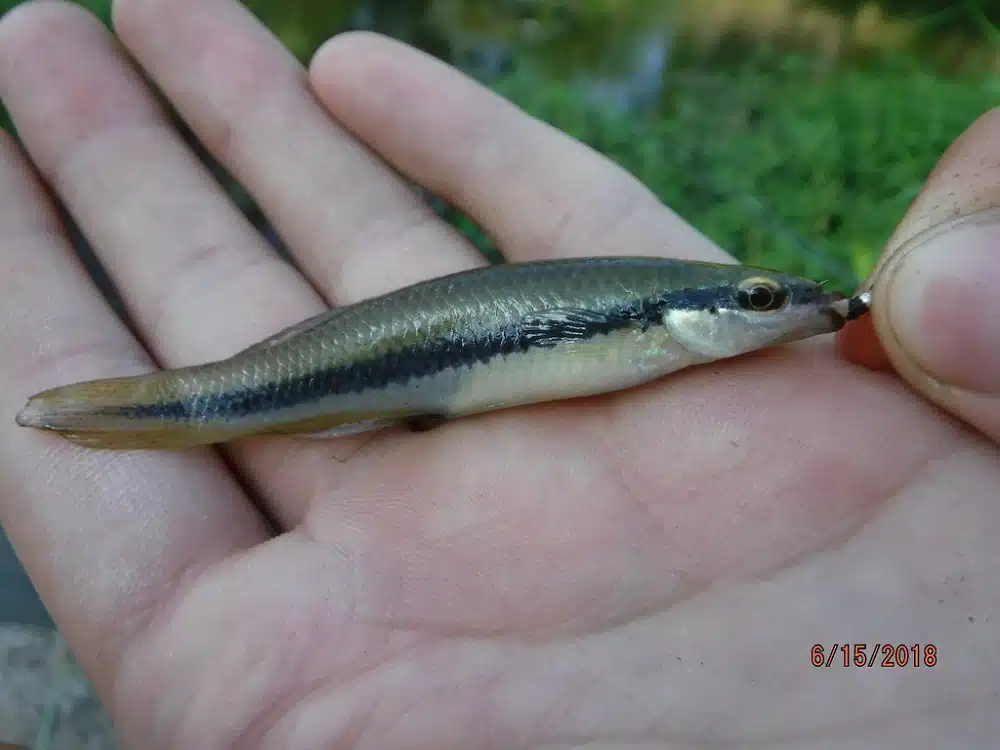
These small fish species (Fundulus notatus) show distinct coloring between sexes. Males show dark vertical bars while females have no bars at all.
Small, colorful, and present in shallow water, Blackstripe Topminow fish are found in the Southern parts of Lake Michigan.
Fish of this genus can be seen at the edges of the lake up to mid-summer, during the spawning season.
Blackstriped Topminow feeds on various insects and arachnids such as water spiders.
33. Yellow Bullhead

Yellow Bullhead fish (Ameiurus natalis) are some of the most versatile species in the state in terms of habitat.
It can live in clear water but it is also adapted to living in areas with plenty of algae and low oxygen levels.
As a species without scales, Yellow Bullhead is a prized species by fishermen.
This type of fish eats both plants and animals. As a scavenger, it can eat both living and dead plants and animals.
Living and dead snails are among the most common type of food this fish can be caught with.
34. Spottail Shiner

A common sight along The Great Lakes, Spottail Shiner (Notropis hudsonius) is a species of fish that are rather short and that live in shallow water with sandy or rocky shorelines.
A size of just a few inches is specific to this fish.
In lakes as large as The Great Lakes, this type of fish shows adaptability but it still lives in the shallowest parts in depths of up to tens of feet.
Only the largest Spottail Shiner reach a length of 8 inches but they may still be used as bait for larger game.
Spottail Shiner are used as bait for walleye and other predators.
35. Golden Shiner

These types of fish (Notemigonus crysoleucas) are found in small groups in the state’s lakes and ponds. They are among the few species that can be trained for feeding in different areas at different hours.
This species has dark green, olive, or dark gray dorsal coloring and light gray lateral coloring.
Growing to a size of up to 12 inches, Golden Shiner are present in The Great Lakes as well as throughout the St. Lawrence River Basin Eastwards.
36. Banded Killifish

Banded Killifish (Fundulus diaphanus) is a small species that are mostly active at noon.
A species present around The Great Lakes, Banded Killifish have gray, olive, and brown coloring.
This small fish species feeds on various crustaceans and insects.
Young Banded Killifish mostly feed on smaller insects or larvae. Midges and their larvae are among the common foods of fish.
These fish are easy to spot as they live together in large groups.
37. Johnny Darter

One of the smallest species of the state is Johnny Darter fish.
This small species (Etheostoma nigrum) has bright coloring and it grows to a size between 1.5 and 2.8 inches.
Murky waters are areas specific to the species which prefers to hide from possible predators. Insects such as mayflies are a typical food for these fish.
The spawning period for Johnny Darter extends into June, depending on temperature.
38. Hornyhead Chub

Hornyhead Chub fish (Nocomis biguttatus) are mostly known as local bait for large game.
These types of fish only grow to a few inches and have no other interest to anglers.
Many types of insects as well as algae are part of their diet. Crayfish and snails are known to be eaten by some of the larger Hornyhead Chub.
39. Northern Redbelly Dace

Tan, gray, black, and orange are colors specific to the small Northern Redbelly Dace (Chrosomus eos).
Fish of this genus prefer to live in small lakes but they might also be found in certain regions across The Great Lakes.
These types of fish are used as bait both by amateur fishermen and in commercial fishing techniques.
Fish of this species also help the local ecosystem by controlling algae growth as they can eat various types of algae.
40. Goldfish

Goldfish (Carassius auratus) are an example of invasive species that are raised in aquariums across the state.
This species has also been confirmed in harbors along The Great Lakes.
If they remain small in aquariums, Goldfish may grow a few more inches in The Great Lakes.
These fish are now known as Supersized Goldfish in The Great Lakes where they have probably been introduced from aquariums.,
41. Northern Hog Sucker

Living on pebbles on the bottom of streams and rivers, Northern Hog Sucker fish (Hypentelium nigricans) are among the few sucker species in Michigan.
They feed by elongating their mouths similar to sucking food.
Various types of plants, algae, and insects are eaten by these fish.
Northern Hog Sucker fish may still be found in clear fast-moving streams and rivers in the state.
42. Spotfin Shiner

Streams and small rivers are ideal habitats for the Spotfin Shiner (Cyprinella spiloptera).
This is a species that eats various types of bugs and insects at the surface of the water.
Fish of the species can be seen spawning in areas with creeks in streams and small rivers. Spawning typically lasts through the summer, into August.
While not the most common species, Spotfin Shinner fish have stable numbers across the state.
43. Common Logperch

Common Logperch fish (Percina caprodes) is a native species found in The Great Lakes as well as East into the St. Lawrence River.
This species is affected by human activity the most. Dams tend to limit their migratory paths the most.
Fish of the Common Logperch family grow up to a length of 8 inches.
Aquatic insects tend to be eaten by the species the most. Common Logperch also faces steep food competition from invading species.
The Round Goby is one of the invasive species which outcompetes it for food around The Great Lakes.